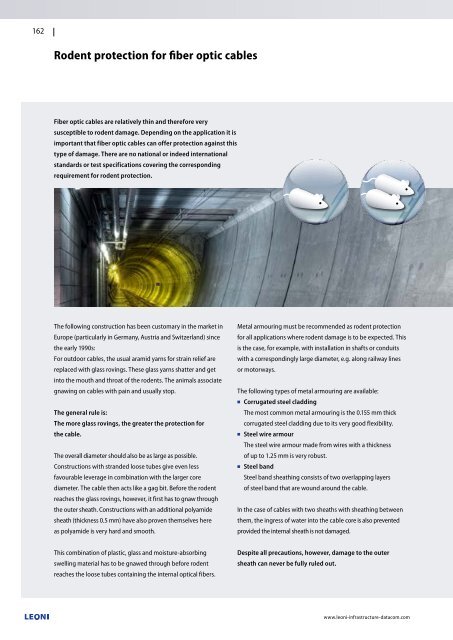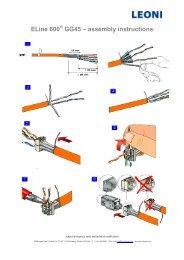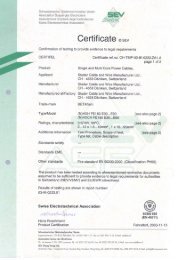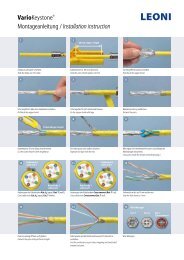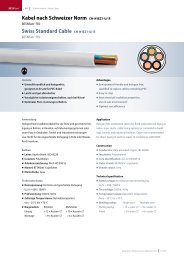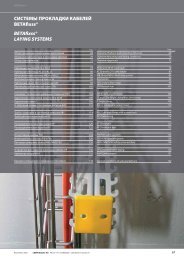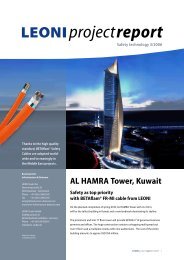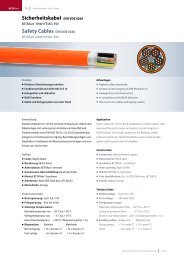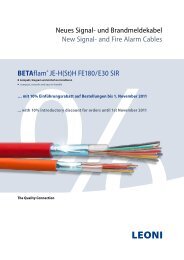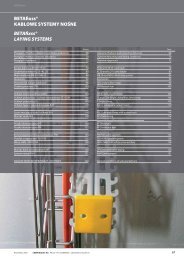- Page 1 and 2:
The Quality ConnectionMegaLine ® ,
- Page 4 and 5:
4Welcome to the datacom mega storef
- Page 6 and 7:
6The LEONI GroupCable expertise for
- Page 8 and 9:
8Quality and environmental manageme
- Page 10 and 11:
10MegaLine ®copper data cableswww.
- Page 12 and 13:
12SPACE conceptFinding the right da
- Page 14:
14SPACE conceptSPACE - PerformanceC
- Page 17 and 18:
OfficeIndustryDataCenterSPACE conce
- Page 19 and 20:
OfficeIndustryDataCenter19Type code
- Page 21 and 22:
OfficeIndustryDataCenter21MegaLine
- Page 23 and 24:
OfficeIndustryDataCenter23Electrica
- Page 25 and 26:
OfficeIndustryDataCenter25Electrica
- Page 27 and 28:
OfficeIndustryDataCenter27Electrica
- Page 29 and 30:
OfficeIndustryDataCenter29Electrica
- Page 31 and 32:
OfficeIndustryDataCenter31Electrica
- Page 33 and 34:
Office Industry DataCenter33Electri
- Page 35 and 36:
Office Industry DataCenter35Electri
- Page 37 and 38:
Office Industry DataCenter37Electri
- Page 39 and 40:
Office Industry DataCenter39Electri
- Page 41 and 42:
Office Industry DataCenter41Electri
- Page 43 and 44:
Office Industry DataCenter43Electri
- Page 45 and 46:
Office Industry DataCenter45Electri
- Page 47 and 48:
OfficeIndustryDataCenter47Electrica
- Page 49 and 50:
OfficeIndustryDataCenter49Electrica
- Page 51 and 52:
Office Industry DataCenter51Electri
- Page 53 and 54:
Office IndustryDataCenter53Electric
- Page 55 and 56:
Office IndustryDataCenter55Electric
- Page 57 and 58:
Office IndustryDataCenter57Electric
- Page 59 and 60:
Office IndustryDataCenter59Electric
- Page 61 and 62:
Office IndustryDataCenter61Electric
- Page 63 and 64:
Office IndustryDataCenter63Electric
- Page 65 and 66:
Office IndustryDataCenter65Electric
- Page 67 and 68:
Office IndustryDataCenter67Electric
- Page 69 and 70:
Office IndustryDataCenter69Electric
- Page 71 and 72:
Office IndustryDataCenter71Electric
- Page 73 and 74:
OfficeIndustryDataCenter73VarioKeys
- Page 75 and 76:
OfficeIndustryDataCenter75VarioKeys
- Page 77 and 78:
OfficeIndustryDataCenter77VarioKeys
- Page 79 and 80:
OfficeIndustryDataCenter79The follo
- Page 81 and 82:
OfficeIndustryDataCenter81VarioKeys
- Page 83 and 84:
OfficeIndustryDataCenter83VarioKeys
- Page 85 and 86:
Office Industry DataCenterIndustry8
- Page 87 and 88:
OfficeIndustryDataCenter87VarioKeys
- Page 89 and 90:
OfficeIndustryDataCenter89VarioKeys
- Page 91 and 92:
OfficeIndustryDataCenter91Cable ass
- Page 93 and 94:
OfficeIndustryDataCenter93MegaLine
- Page 95 and 96:
OfficeIndustryDataCenter95LEO (Ligh
- Page 97 and 98:
OfficeIndustryDataCenter97MegaLine
- Page 99 and 100:
OfficeIndustryDataCenter99MegaLine
- Page 101 and 102:
OfficeIndustryDataCenter101MegaLine
- Page 103 and 104:
OfficeIndustryDataCenter103Accessor
- Page 105 and 106:
OfficeIndustryDataCenter105ELine 12
- Page 107 and 108:
OfficeIndustryDataCenter1072 data s
- Page 109 and 110:
Office Industry DataCenter109ELine
- Page 111 and 112: OfficeIndustryDataCenter111ELine 12
- Page 113 and 114: OfficeIndustryDataCenter113ELine 12
- Page 115 and 116: OfficeIndustryDataCenter115ELine 12
- Page 117 and 118: OfficeIndustryDataCenter117MegaLine
- Page 119 and 120: OfficeIndustryDataCenter119MegaLine
- Page 121 and 122: OfficeIndustryDataCenter121MegaLine
- Page 123 and 124: OfficeIndustryDataCenter123MegaLine
- Page 125 and 126: OfficeIndustryDataCenter125MegaLine
- Page 127 and 128: OfficeIndustryDataCenter127MegaLine
- Page 129 and 130: OfficeIndustryDataCenter129MegaLine
- Page 132 and 133: 132MegaLine ® Trunk cable, industr
- Page 134 and 135: 134MegaLine ® Trunk cable, 8 port
- Page 136 and 137: 136MegaLine ® Connect45 trunk cabl
- Page 138 and 139: 138MegaLine ® Connect45 CP cablePr
- Page 140 and 141: 140MegaLine ® Patch accessoriesfor
- Page 142 and 143: 142MegaLine®Acceptance measurement
- Page 144 and 145: 144ChannelClass E/E A /F/F AFrequen
- Page 146 and 147: 146Acceptance measurement Class E A
- Page 148 and 149: 148Acceptance measurement Class F A
- Page 150 and 151: 150Alien crosstalkAlienX(AXT)EMISwi
- Page 152 and 153: 152GigaLine ®FO data cableswww.leo
- Page 154 and 155: 154GigaLine ® FO data cablesThe fi
- Page 156 and 157: 156Comparison of requirementsFiber
- Page 158 and 159: 158GigaLine ® Fiber qualitiesFiber
- Page 160 and 161: 160GigaLine ® Type codesfor easy a
- Page 164 and 165: 164Handling and safety noticeswhen
- Page 166 and 167: 166GigaLine ® Indoor cable, duplex
- Page 168 and 169: 168GigaLine ® Breakout cableTypeKL
- Page 170 and 171: 170GigaLine ® Universal cable, cen
- Page 172 and 173: 172GigaLine ® Universal cable, cen
- Page 174 and 175: 174GigaLine ® "Fire secured" unive
- Page 176 and 177: 176GigaLine ® Outdoor cable, centr
- Page 178 and 179: 178GigaLine ® Outdoor cable, centr
- Page 180 and 181: 180GigaLine ® Outdoor cable, stran
- Page 182 and 183: 182GigaLine ®FO connectivitywww.le
- Page 184 and 185: 184GigaLine ® FO cabling systemsHi
- Page 186 and 187: 186www.leoni-infrastructure-datacom
- Page 188 and 189: 188GigaLine ® Fiber optic trunk bo
- Page 190 and 191: 190GigaLine ® Fiber optic splice b
- Page 192 and 193: 192GigaLine ® Fiber optic splice b
- Page 194 and 195: 194www.leoni-infrastructure-datacom
- Page 196 and 197: 196GigaLine ® Compact fiber optic
- Page 198 and 199: 198GigaLine ® Compact fiber optic
- Page 200 and 201: 200www.leoni-infrastructure-datacom
- Page 202 and 203: 202GigaLine ® Fiber optic office a
- Page 204 and 205: 204www.leoni-infrastructure-datacom
- Page 206 and 207: 206GigaLine ® FTTD wall outletsfor
- Page 208 and 209: 208GigaLine ® FTTD outlet for cabl
- Page 210 and 211: 210GigaLine ®FO patch cords / trun
- Page 212 and 213:
212GigaLine ® Fiber optic patch co
- Page 214 and 215:
214GigaLine ® Fiber optic patch co
- Page 216 and 217:
216GigaLine ® Fiber optic patch co
- Page 218 and 219:
218www.leoni-infrastructure-datacom
- Page 220 and 221:
220GigaLine ® Fiber optic trunk ca
- Page 222 and 223:
222GigaLine ® Fiber optic trunk ca
- Page 224 and 225:
224GigaLine ® Fiber optic trunk ca
- Page 226 and 227:
226GigaLine ® Fiber optic trunk ca
- Page 228 and 229:
228GigaLine ®DataCenter Linkswww.l
- Page 230 and 231:
230GigaLine ® DataCenter linksQuic
- Page 232 and 233:
232GigaLine ® DataCenter linkConne
- Page 234 and 235:
234GigaLine ®Acceptance measuremen
- Page 236 and 237:
236VarioLine ®Modular system perip
- Page 238 and 239:
238www.leoni-infrastructure-datacom
- Page 240 and 241:
240VarioLine ® Consolidation point
- Page 242 and 243:
242VarioLine ® Module panels with
- Page 244 and 245:
244VarioLine ® Floor outletround/r
- Page 246 and 247:
246www.leoni-infrastructure-datacom
- Page 248 and 249:
248VarioLine ® DClink frame 19"/1
- Page 250 and 251:
250VarioLine ® DataCenter cable ro
- Page 252 and 253:
252www.leoni-infrastructure-datacom
- Page 254 and 255:
254VarioLine ® UF - underfloor sys
- Page 256 and 257:
256System overview - based on GigaL
- Page 258 and 259:
258VarioLine ® Mounting plates for
- Page 260 and 261:
260VarioLine ® Adapter panels for
- Page 262 and 263:
262VarioLine ® Excess-length modul
- Page 264 and 265:
264Field of applicationOfficewww.le
- Page 266 and 267:
Field of applicationIndustrywww.leo
- Page 268 and 269:
268Industrial IT cablingUniform IT
- Page 270 and 271:
270Industrial IT cablingVarioKeysto
- Page 272 and 273:
272Field of applicationDataCenterww
- Page 274 and 275:
274Requirements and solutionsFast -
- Page 276 and 277:
276Comparison of cabling systemsSin
- Page 278 and 279:
278IndexIntroduction 2Portfolio 2Co
- Page 280:
Find out more:Business Unit Infrast


